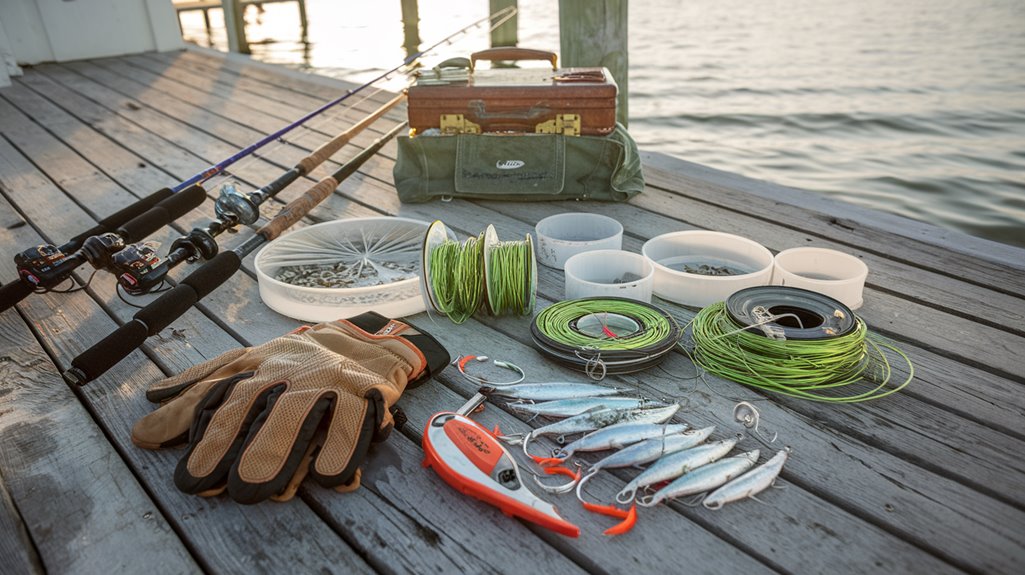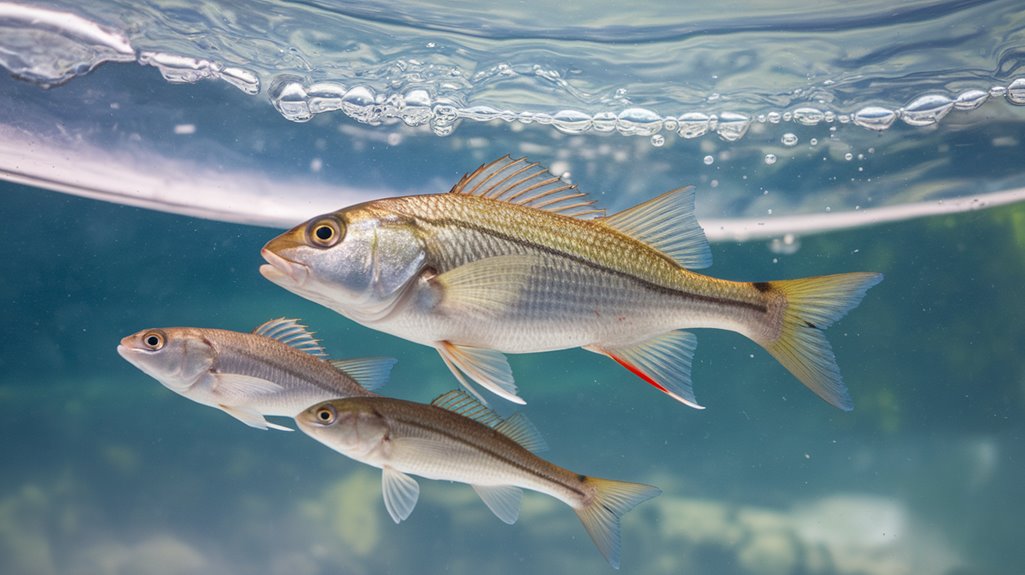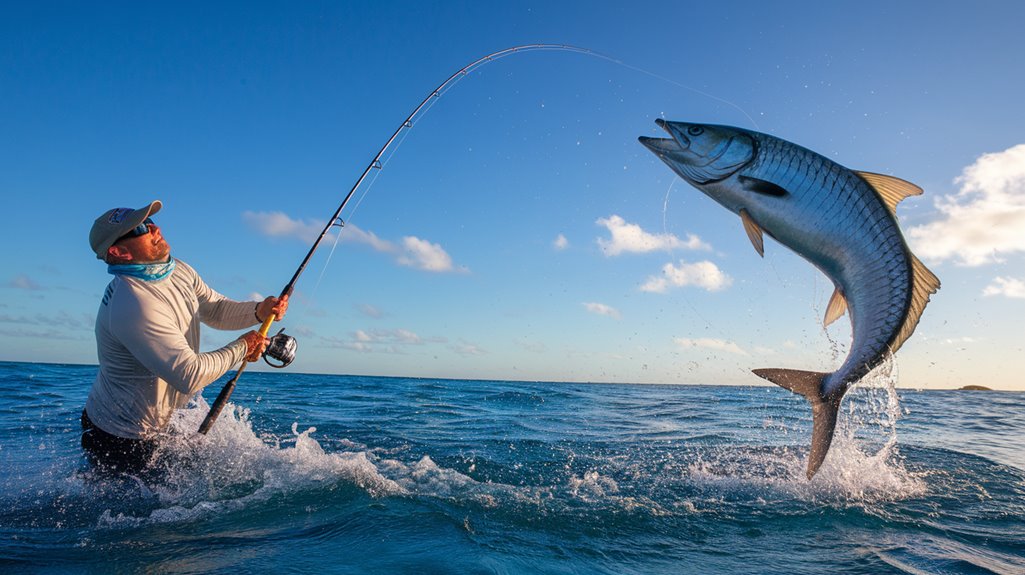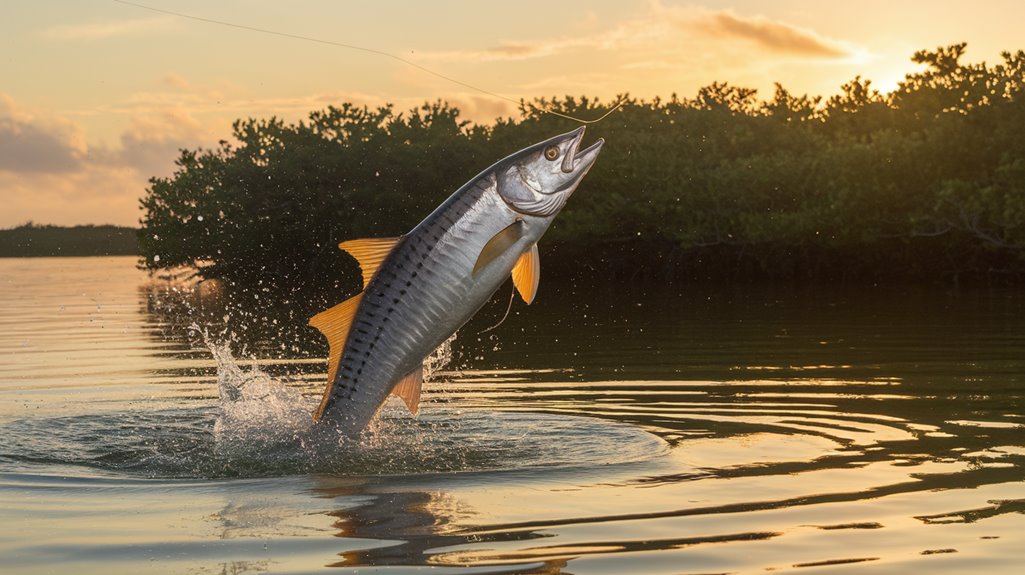You’re about to discover why tarpon fishing ranks among the most thrilling saltwater pursuits you’ll ever experience. These powerful gamefish, known as “silver kings,” can exceed 150 pounds and leap spectacularly when hooked. Whether you’re casting from flats skiffs in Florida or working dock lights in the Caribbean, landing your first tarpon demands specific gear, technical knowledge, and proven tactics. Let’s explore the essential elements you’ll need to join the ranks of successful tarpon anglers.
- Key Takeaways
- Essential Gear for Tarpon Success
- Understanding Tarpon Behavior
- Best Times and Seasons
- Selecting the Right Bait
- Mastering Basic Techniques
- Fighting and Landing Methods
- Prime Fishing Locations
- Weather and Water Conditions
- Safety Precautions on the Water
- Conservation and Handling Ethics
- Frequently Asked Questions
- Conclusion
Key Takeaways
- Use a medium-heavy rod with 5000 spinning reel and 65-pound braided line for optimal tarpon fishing setup.
- Target tarpon during dawn and dusk in warm coastal waters, especially during spawning season from March to August.
- Choose live bait like menhaden or small crabs, ensuring they match local prey species for better success.
- Master the “bow to the king” technique during jumps and maintain steady pressure to prevent line breakage.
- Focus on locations near structures during outgoing tides, and always follow proper catch-and-release protocols for conservation.
Essential Gear for Tarpon Success

Three key components form the foundation of your tarpon fishing setup: a medium-heavy rod with a 5000 spinning reel, a fluorocarbon leader of at least 30 pounds, and circle hooks sized 3/0 or larger. These essentials provide the backbone needed to handle tarpon’s powerful runs and acrobatic jumps while maintaining stealth in the water.
When targeting larger tarpon, you’ll need to upgrade your fishing line to at least 65-pound braided line for peak control and fighting capability. The fluorocarbon leader guarantees your presentation remains invisible while offering the strength required for extended battles. Don’t forget to equip yourself with proper handling gloves – they’re vital for protecting both you and the fish during the catch and release process, guaranteeing a safe and successful fishing experience.
Understanding Tarpon Behavior
You’ll find tarpon congregating in warm coastal waters during their March to August spawning season, following large schools of baitfish like menhaden and mullet. To maximize your success, focus your fishing efforts during dawn and dusk when these prehistoric predators are most actively feeding near the surface. Your ability to read their daily movement patterns and approach quietly with trolling motors or paddles will determine whether these wary fish remain in the area or spook away from your presentation.
Feeding Patterns and Migration
Understanding tarpon behavior is essential for successful angling, as these majestic fish follow distinct feeding and migration patterns throughout the year. You’ll find that tarpon’s feeding patterns peak during dawn and dusk, when they’re most actively hunting baitfish like menhaden and mullet. These prime feeding times offer your best chances for a successful catch.
Migrating tarpon follow predictable seasonal movements from March to November, with peak activity during warmer months. They’ll seek warmer, shallow waters in spring and summer for spawning and feeding. You’ll want to focus on areas where outgoing tides push bait towards deeper waters, particularly near structures like bridges and inlets. Water temperature greatly influences their migration routes, so tracking these changes will help you locate schools of tarpon throughout their seasonal journey.
Daily Movement Habits
Tarpon exhibit distinct daily movement patterns that align with their hunting and survival instincts. You’ll find them most active during dawn and dusk, when they’re aggressively pursuing schools of baitfish like menhaden and mullet. Their daily movement habits are heavily influenced by tidal cycles, particularly during outgoing tides when prey becomes more concentrated near shorelines.
For successful tarpon fishing, focus on shallow waters near structural features where they ambush their prey. During the peak months of March through August, you’ll notice increased activity as these powerful fish patrol their feeding grounds. They’re particularly drawn to areas with strong currents and natural barriers, using these features to their advantage while hunting. Understanding these daily movement patterns is vital for anticipating where and when to find actively feeding tarpon.
Reaction to Weather Changes
When tracking weather patterns for tarpon fishing, you’ll notice these powerful gamefish exhibit distinct behavioral shifts that align with atmospheric changes. During stable weather conditions, especially in morning hours and around tide changes, you’ll find tarpon actively feeding and more receptive to your presentations.
You’ll achieve the best results fishing for tarpon during periods of warm weather and high barometric pressure, as these conditions trigger increased movement patterns. However, watch for approaching storms or cold fronts, as tarpon will typically retreat to deeper waters or structure for shelter. Monitor baitfish behavior – their scattering often signals impending weather changes and corresponding tarpon movements. Sudden temperature drops and heavy rainfall can greatly reduce tarpon activity, so plan your trips around stable weather windows for ideal success.
Best Times and Seasons
To maximize your chances of landing a trophy tarpon, timing your fishing expedition during peak seasons and perfect hours is essential. Your best opportunities occur from March through November, with the tarpon bite being particularly strong during warmer months. Strategic timing around sunrise until noon offers prime fishing conditions, while sunset presents another productive window.
Plan your trips around outgoing tides when baitfish get pushed toward shore, creating perfect feeding conditions for tarpon. Focus on locations where you’ll find:
- Schools of menhaden, LY, or Pogey moving along the shoreline
- Tidal flows near inlets or passes where baitfish concentrate
- Dawn-lit waters with visible bait pods breaking the surface
Understanding these temporal patterns and combining them with ideal tide conditions will greatly improve your success rate targeting these magnificent gamefish.
Selecting the Right Bait

Choosing the right bait stands as one of the most critical decisions you’ll make in your tarpon fishing strategy. Live bait proves consistently effective, with menhaden, large greenbacks, and small crabs in the 4-5 inch range delivering ideal results. You’ll want to match your bait selection to the local prey species that tarpon naturally target in your fishing area.
When live bait isn’t available, you’ve got options. Fresh dead or cut bait can serve as effective alternatives. For those preferring artificial lures, swimbaits and topwater plugs that mimic natural prey movements can produce strikes. The key is understanding that a variety of baits can work, but success often depends on how well your choice aligns with the tarpon’s natural feeding patterns in your specific location.
Mastering Basic Techniques
Once you’ve selected your bait, mastering the fundamental techniques will dramatically improve your tarpon fishing success. For ideal control, utilize a medium-heavy rod paired with a 5000 spinning reel. When fishing for tarpon, keep your rod tip low near the water’s surface during retrieval to avoid spooking these powerful gamefish.
Essential tips and tricks include mastering the strip-strike technique – wait for the tarpon to fully close its mouth before setting the hook. Remember to “bow to the king” by lowering your rod tip during jumps to prevent line breaks.
- Your rod tip slicing through the morning mist, inches above the rolling waves
- Line peeling off your reel as a silver king launches skyward
- Your arms straining against the raw power of a tarpon’s first run
Fighting and Landing Methods

When you’re fighting a tarpon, you’ll need to master essential rod control techniques, including lowering your rod tip during jumps and maintaining steady pressure throughout the battle. Your success depends on finding the perfect balance between applying enough force to tire the fish while avoiding excessive strain that could snap your line. Proper landing tactics require you to let the tarpon wear itself down rather than chasing it, increasing your chances of a successful catch-and-release while keeping both you and the fish safe.
Fighting With The Rod
The explosive moment a tarpon takes your bait marks the beginning of an intricate battle between angler and fish. When you feel the strike, quickly clear your line and set the hook with an upward motion to secure it in the tarpon’s hard mouth. Master the “bow to the king” technique by bending at the waist during jumps, while simultaneously lowering your rod tip to reduce line pressure.
- Picture yourself locked in a graceful dance, rod bending as the silver king launches skyward
- Visualize the precise moment you adjust your drag, responding to each powerful run
- Imagine maintaining perfect tension as you guide the massive fish through its acrobatic display
Control your battle rhythm by managing the drag tension and consistently responding to the tarpon’s movements. This strategic approach helps prevent line breakage while gradually tiring the fish.
Landing Tactics That Work
Successfully landing a tarpon demands a calculated blend of technique, patience, and endurance throughout the fight. When you’re working to catch tarpon, maintain steady pressure through controlled drag settings while avoiding the temptation to chase the fish. Bow to the tarpon during jumps to prevent tippet breakage, and clear your line swiftly after the initial bite.
| Action | Purpose |
|---|---|
| Bow to Jumps | Reduces pressure on tippet |
| Control Drag | Tires fish systematically |
| Quick Line Clear | Maintains tension control |
Your landing tactics must include a strong, precise hookset by striking upward while reeling. Don’t get discouraged by fall-offs – they’re common even among experienced anglers. Focus on maintaining consistent pressure and responding to the fish’s movements with calculated adjustments to your technique.
Prime Fishing Locations
Several world-class destinations stand out for prime tarpon fishing, with Florida’s coastal waters leading North American hotspots. You’ll find excellent opportunities in the Florida Keys year-round, while Boca Grande offers peak action from May to July. Texas’s Gulf Coast and South Carolina’s waterways provide strategic points to fish for tarpon during their seasonal migrations.
For the ultimate tarpon experience, consider these distinctive characteristics:
- The Florida Keys’ crystal-clear flats allow for sight fishing opportunities
- Boca Grande Pass’s deep channels create perfect ambush points during migrations
- South Carolina’s cooler waters offer unique fall and winter fishing scenarios
International destinations like Costa Rica and Belize complement these domestic options, offering world-class tarpon fishing in tropical settings with consistent year-round action.
Weather and Water Conditions
You’ll greatly boost your tarpon fishing success by targeting outgoing tides when bait fish are naturally pushed toward shorelines and structure. Your chances of landing these magnificent gamefish increase during periods of light wind between 5-10 mph, which helps mask your presence while maintaining ideal casting conditions. While tarpon can be caught in various weather conditions, you should avoid fishing during severe storms, extremely high winds, or when water temperatures fall below 75°F, as these conditions drastically reduce tarpon activity and feeding behavior.
Ideal Tides For Success
When pursuing tarpon, understanding tidal patterns and weather conditions can make the difference between a successful outing and a frustrating day on the water. You’ll find perfect tides for success during the outgoing tide, when baitfish are pushed toward shore. Pay attention to the critical shift periods—specifically the last hour of incoming and first hour of outgoing tides—as these windows offer prime feeding opportunities.
- Strong tidal movements in channels and inlets concentrate baitfish, creating natural feeding zones
- Overcast skies with light winds improve visibility and encourage surface feeding
- Full moon phases intensify tidal movements, triggering more aggressive feeding patterns
For best results, time your fishing trips around these peak tidal periods, particularly during overcast conditions when tarpon are most active near the surface.
Avoiding Bad Weather Conditions
Bad weather conditions pose significant challenges for tarpon fishing success, making it essential to recognize and avoid unfavorable circumstances. You’ll need to monitor several key environmental factors before heading out with your bait. Strong winds and storms disrupt normal feeding patterns, while cold fronts cause tarpon to become lethargic and less responsive to your offerings.
For ideal results, plan your fishing trips during stable weather patterns when water temperature ranges between 75°F and 85°F. Overcast conditions can work to your advantage, as tarpon often feed more actively when direct sunlight is reduced. You’ll want to avoid days with approaching cold fronts or significant temperature drops, as these conditions dramatically decrease your chances of a successful catch.
Safety Precautions on the Water
Safety on the water demands three fundamental priorities when tarpon fishing: personal protection, environmental awareness, and emergency preparedness. Keep in mind that your life jacket is your most vital piece of safety equipment – wear it properly at all times. You’ll need to maintain constant awareness of weather conditions and have a reliable communication plan with contacts onshore. Always verify your safety equipment is readily accessible and in working order.
- A properly fitted life jacket securely fastened across your chest, allowing full mobility while fishing
- A waterproof first aid kit strategically mounted within arm’s reach of the helm
- Emergency signaling devices, including flares and a VHF radio, stored in a water-resistant container
These safety precautions aren’t just recommendations – they’re essential practices that can make the difference between a successful fishing trip and a dangerous situation.
Conservation and Handling Ethics
Responsible tarpon fishing hinges on ethical handling practices and a deep commitment to conservation. You’ll need to master proper catch-and-release techniques to guarantee these magnificent fish survive and thrive for future generations. Always handle tarpon with wet hands to protect their essential slime coating, which guards against infections and maintains their health.
Following local regulations is essential for conservation efforts. In most areas, particularly Florida, you’re required to practice catch-and-release. Keep larger tarpon in the water during the release process unless you have a valid harvest tag, as lifting them can cause significant stress and injury. By adhering to these handling ethics, you’re contributing to sustainable fishing practices and helping preserve tarpon populations for years to come.
Frequently Asked Questions
What Is the Best Setup for Tarpon Fishing?
You’ll need a 9ft spinning rod, 65lb braided line, 5/0-7/0 circle hooks, and 5-6ft leader rated 60-80lb. Pair this with live bait like thread fins for best results.
What Month Is Best for Tarpon Fishing?
You’ll find peak tarpon fishing in May through July during their migration. These months offer ideal water temperatures and the highest concentration of fish in shallow coastal waters.
What Size Hooks to Use for Tarpon Fishing?
You’ll want to use 5/0 to 7/0 circle hooks for tarpon fishing, with 7/0 being ideal for larger fish. Match your hook size to your bait, typically 4-5 inches long.
Do I Need a Leader for Tarpon?
Yes, you’ll absolutely need a leader for tarpon fishing. Use 60-100 pound fluorocarbon or mono leader, 5-6 feet long, to protect against their sharp teeth and powerful runs.
Conclusion
You’ve now got the foundational knowledge to begin your tarpon fishing journey. Remember to match your gear to the conditions, respect seasonal patterns, and always prioritize ethical handling practices. While you’ll face challenges as you develop your technique, staying committed to proper form and conservation principles will make you a more effective angler. Keep refining these skills, and you’ll soon master the art of landing these magnificent gamefish.

